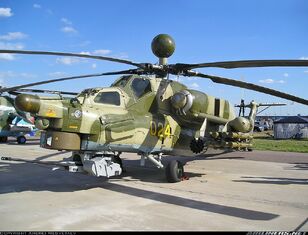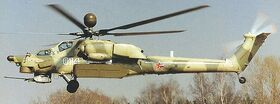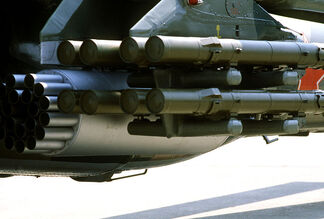The Mil Mi-28 Night Hunter (NATO reporting name: "Havoc", GV Devastation) is a two-seat Russian combat helicopter.
Description[]
The attack helicopter Mil Mi 28N Night Hunter is the latest version of the model Havoc, produced for an open competition in

Mi-28 Night Hunter
the early 80s by the Soviet government for a new combat helicopter to replace the Mil Mi 24 Hind in antitank missions, able to counter NATO's sophisticated battle tanks. Yet, this competition was won by advanced Kamov Ka-50 Hokum. However, the development of the Mil Mi-28 was continued, though with less priority, to offer new versions with significant enhancements in performance, avionics and weapons to the Russian military. On November 14, 1996, a prototype of the latest version of the Mil Mi-28 equipped for both, day or night combat made its first flight. Yet, it took another eight years, until April 2004, for the production version to make its first flight. Since then, this advanced version, known as the Mil Mi-28N was nicknamed Night Hunter, in reference to his ability to attack at night. The Mi-28 has a more conventional design than its competitor Ka-50 and its two-piece x-configuration tail rotor is similar to that found on the American Apache combat helicopter. This feature allows a reduction of noise of the tail rotor. Because the Mi-28 is a combat helicopter working close to the battle field, armour is a feature that could not be forgotten about. Its armour is capable of sustaining impacts of projectiles of caliber 12.7 mm (.50) and 20 mm grenades, specifically in the area of the cabin.
Electronics[]
The Mi-28 is equipped with a millimeter wave radar mounted above the rotor, just like the Apache Longbow radar. This radar, an

In this photo we see an Mi-28 equipped with a dispenser of submunitions in the rack outside. Literally a "suitcase" full of bomblets.
N-025-280 Almaz, is able to detect a ground target 10 km away and fire guided missile AT-9 Spiral 2 at them. Below the nose of the Mi-28 is a turret targeting system TOR, a sensor with FLIR (= Forward Lokking InfraRed, thermal imaging camera) used for target designation and navigation, a TV camera, and a laser target designator used to guide laserguided missiles mounted on a turret. This suite of sensors provides the Mi-28 with the most complete navigation and target designation capability.
Performance[]
This powerful helicopter can reach a top speed of 300 km/h, thanks to its two Klimov TV-3-117KM engines producing 2500 hp each. This engine is a version of the engine used in Kamov Ka-50 Black Shark, with improved performance. These engines also show a rate of climb in the order of 820 m/min, which can be considered an excellent performance compared to helicopters of the same class. This rate of increase is double that of the similar American AH-64 Apache Longbow.
Armament[]

The eight outer tubes in this photo are AT-6 Spiral missiles while the rocket pod on the rack internal carries 20 rockets.
The offensive capability of this "flying tank" could be classified as impressive. The weight of arms can exceed 2300 kg. The Mi-28 can transport a combination of 16 anti-tank missiles like the AT-6 Spiral (9K114 Shturm) with a range of 6 km and guided by radio, or the missile AT-9 Spiral 2 (9M120 Ataka V) at 6 km range and guided by radio. The AT-9 is more accurate and destructive against armor than the AT-6. Two rocket pods of the calibers 80 mm and 122 mm are also often used. The Mi-28 is armed with a 2A42 30 mm cannon with controlled rate of fire of 900 rounds per minute and loaded with 300 cartridges. The gun's muzzle velocity is 1000 m/sec. This gun, said to be the most powerful ever installed on a helicopter, can destroy light and medium armor and cause serious damage to an MBT. The Mi-28 is in use in the Russian military with 16 units already delivered. It is expected that this number is going to rise to 300 units in the coming years.
Variants
- Mi-28A: First prototype with a conventional three-bladed tail rotor. First flight 1982
- Mi-28A: Improved prototype for a planned series. With more modern Avionics and TV-3-117VM Engines, each with 2200 hp. First flight 1988th
- Mi-28N: night combat and all-weather version. Equipped with mastmontiertem FH-01 Arbalet MM-Radar, FLIR and Night vision device. Take-off weight 11,500 kg, 2350 kg weapons load. Retrofitted with TV3 117WMA-SB3 Engines with 2,500 hp. Armed with up to 16 Tank missile Type AT-9. First flight 1996th
- Mi-28E: Export version of the Mi-28A.
- Mi-28L: Export version of the Mi-28A for use in desert regions.
- Mi-28NAe: In 2004 introduced export version of the Mi-28N for North Korea.
- Mi-28NE: Export version of the Mi-28N.
- Mi-28D: Simplified export version of the Mi-28N-radar and without MM FLIR. Presented at the Aerosalon 2005 Le Bourget.
Specifications[]
General Characteristics[]
- Crew: 1 pilot (rear), 1 navigator/weapons operator (front)
- Length: 17.01 m (55 ft 10 in)
- Rotor diameter: 17.20 m (56 ft 5 in)
- Height: 4.70 m (15 ft 5 in)
- Disc area: 232.35 m² (2,501 ft²)
- Empty weight: 8,600 kg (18,960 lb)
- Loaded weight: 10,700 kg (23,590 lb)
- Max takeoff weight: 11,500 kg (25,350 lb)
- Powerplant: 2× Klimov TV3-117VMA turboshaft, 1,636 kW (2,194 shp) each
Performance[]
- Maximum speed: 320 km/h (172 knots, 199 mph)
- Cruise speed: 270 km/h (145 knots, 168 mph)
- Range: 435 km (234 nmi, 270 mi)
- Combat radius: 200 km (108 nmi, 124 mi) ; with 10 min loiter and 5% reserves
- Ferry range: 1,100 km (593 nmi, 683 mi)
- Service ceiling: 5,700 m (19,000 ft)
Armament[]
- Guns: 1× chin-mounted 30 mm Shipunov 2A42 cannon with 250 rounds (±110° horizontal fire)
- Hardpoints: Two pylons under each stub wing to mount bombs, rockets, missiles, and gun pods. Main armament configurations include:
- 16 Ataka-V anti-tank missiles and 40 S-8 rockets, Or
- 16 Ataka-V anti-tank missiles, and 10 S-13 rocket, Or
- 16 Ataka-V anti-tank missiles, and two 23 mm Gsh-23 gun pods with 250 rounds each.
- Other ordnance: 9K118 Sheksna and 9A-2200 ant-tank missiles, 8 Igla-V and Vympel R-73 air-to-air missiles, 2 KMGU-2 mine
See also[]
- Kamov Ka-50 Black Shark
- Mil Mi-24 Hind
The original article can be found at Mil Mi-28 Night Hunter and the edit history here.